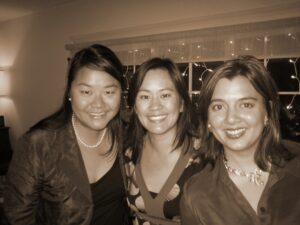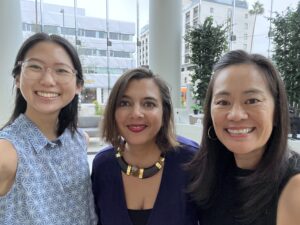
Way-Ting, Jenni, and Mina at Blue Garnet's holiday party in 2006
Interview with Sofia Van Cleve, Dec. 2022
Over a virtual cup of coffee, I sat down with Mina Kumar, our Project Leader tuning in remotely from Austin, Texas. Since we’ve both been working remotely since Mina “boomeranged” back to Blue Garnet, we haven’t met in-person, yet. So I was excited to finally sit down and hear more about Mina’s multifaceted background—from business to academia to consulting to nonprofit leadership. I hope you enjoy our chat and feel Mina’s enthusiasm for participatory evaluation and program design!
What’s your “Blue Garnet Story?” How did you first come to BG, and how did you come back?
I started working at Blue Garnet right out of business school. I had moved to LA with my husband, who got a job teaching at USC. When I graduated, there weren’t many who were leveraging an MBA to go into the social sector— but that’s why I went to business school! I randomly found Blue Garnet’s website and saw that their offices were close to where we lived. I reached out, was surprised to hear back, and then actually became their first full-time employee!
In those two years, I learned a lot about the practice of consulting, but also from working with Jenni and Way-Ting in a small, intimate company. In the second year, we all had babies, so I learned a lot from them about running a business, being an entrepreneur, and being a mother. It was a very memorable year!
From Blue Garnet, I got a particular interest in evaluation, outcomes, and what is practical in measuring impact. So when my husband got a new teaching job at University of Texas, I studied and did research on evaluation in academics. Since then, I’ve been an independent consultant for ten years, with roles in a think tank, academia, and as an interim Chief Programs Officer at a parent service education nonprofit. As I was rolling off the nonprofit role before the pandemic, Way-Ting reached out about working remotely on a BG project. I’m thankful that remote work in the pandemic gave me the opportunity to come back to BG!
You talked about both the academic and practical sides of evaluation. Tell me more about your thoughts on evaluation in the social sector…
What’s attractive to me about the social sector is that one, the final effect of your work is good for the world (ideally). And two, that innovation and entrepreneurship are hallmarks of the sector. Most of my client organizations are started by some visionary who had to do everything to literally keep the lights on. So with evaluation, you need to figure something out that is very practical. Most nonprofits are not running Randomized Control Trials—nor should they! It’s not realistic to hold your program constant for five years and spend half a million dollars.
We need to take what the ideal is, then immediately adjust it to what is practical and applicable for how organizations use data. We need “just enough” verification to figure out if they’re on the right track to meet their goals for the impact they want. And if they’re not on track, then we can do something about it and change up programming on an ongoing basis.
You and I are both part of our Blue Garnet “Extended Team,” working remotely most of the time. As we’re navigating year 3 of adjusted-work environments since the pandemic, what have you learned?
I’ve been working remotely for 12 years, before it was cool! I love a good day working from home in my pajamas doing data analysis, but I know work-from-home is inefficient for collaboration. I had my first post-pandemic, in-person organization retreat in February this year, and we got six months of things done by lunch! It’s so much easier to connect than on Zoom. The foundation of almost all decision-making is the quality of relationships you have with those people, and I think that was missing during the pandemic.
So we’re happy to be back (mostly) to in-person work. We need a mix of working remotely and collaboratively, face-to-face.
Looking back, how does your time at Blue Garnet impact you today?
The biggest takeaway I have from Blue Garnet is how to run a value-driven business with people you really care about personally. Way-Ting and Jenni broke all the rules of being best friends going into business- and it’s worked well! That relational aspect of BG shapes how I approach work and life. I also learned basics of project management, which I use both in my professional and personal life everyday! *laughs* It also catalyzed my deeper interest in participatory evaluation and program design that I use in most of my client work now.
You’ve mentioned participatory evaluation a few times. Could you share more?
The key tenet of participatory evaluation and inclusive program design is to really listen to your customer, or client or participant. We don’t want to treat people just as research subjects but want them to get something out of the process, too. And data is only useful if you’re going to do something good with it—listen, then do something meaningful. It’s always important for the people you serve to feel like co-collaborators, empowered to write their own script.
In action, that can look like prioritizing community engagement in a Strategic Business Plan or training our nonprofit clients with the tools to do community listening regularly. For a Foundation client, we brought in their nonprofit grantees to be part of shaping the program evaluation framework and interpreting the implications of our learnings.
What are you currently reading or listening to? Any recommendations?
- Right now I’m reading The Outlaw Ocean, an investigative journalism book about the lack of law in international waters, leading to illegal fishing and even slavery. I had no idea how bad it was. I grew up in Alaska and now only want to eat the fish we catch ourselves there!
- In other social impact reading, I recommend The Tyranny of Metrics—about when measurement causes unintended consequences if we measure the wrong thing or focus on something that is not meaningful.
- Another great resource on participatory evaluation is “Why am I always being researched?” from Chicago Beyond. This guidebook shares an “equity-based approach to research” to empower our communities, and informs Blue Garnet’s evaluation approach!
- Lastly, I like The Givers: Money, Power, and Philanthropy in a New Gilded Age. Also about unexpected consequences, this is about how philanthropy can mess with democratic outcomes. They use The Highline in New York City as an example of a major project instigated by private philanthropy without involving that neighborhood. Yes, the end result is beautiful, but it circumvented the democratic process that most city projects need to go through. In participatory evaluation, we don’t just want “buy in” from the community after a decision has already been made. We want shared leadership with the community members from the start! This can lead to a much more powerful result.
I hope this helps you get to know Mina a little better! You can read her bio or drop her a question at mina@bluegarnet.net.

Way-Ting, Jenni, and Mina in 2006…

and Sarah, Mina, and Jenni in 2022!
